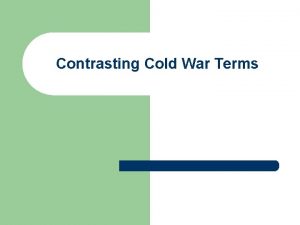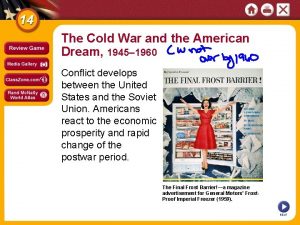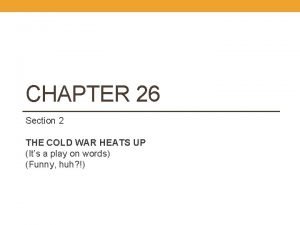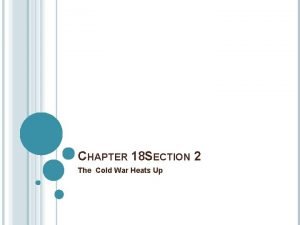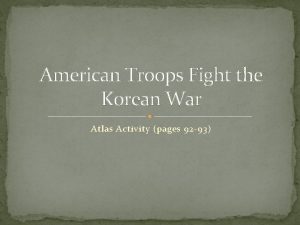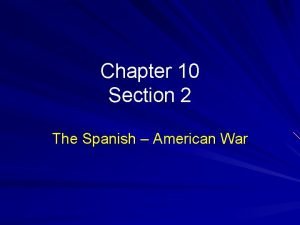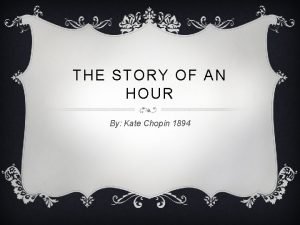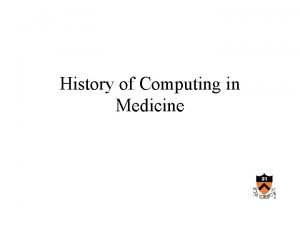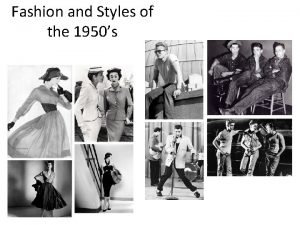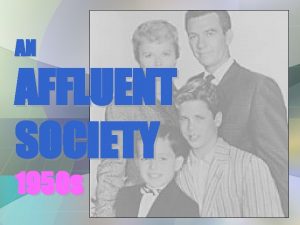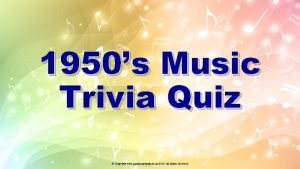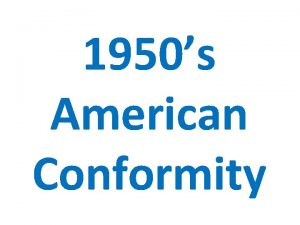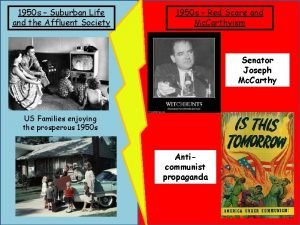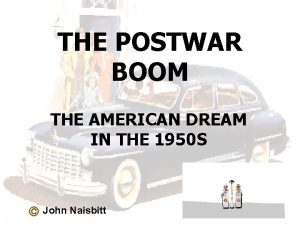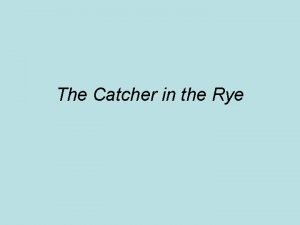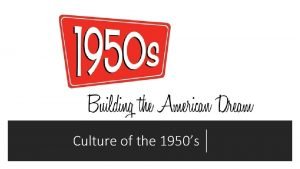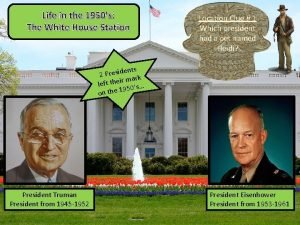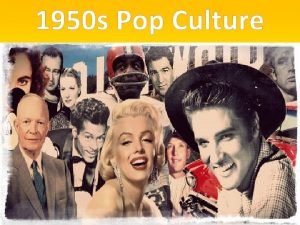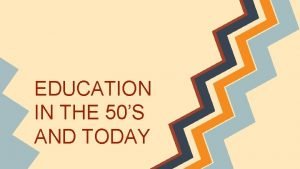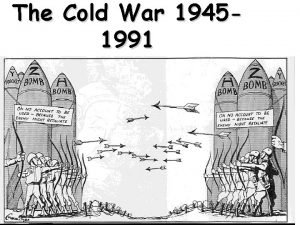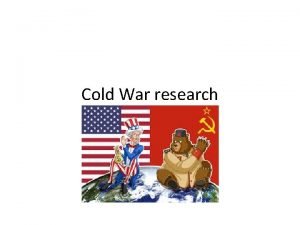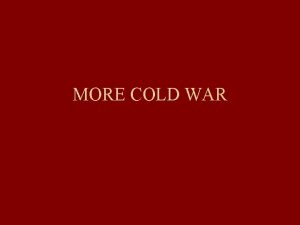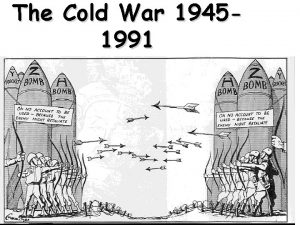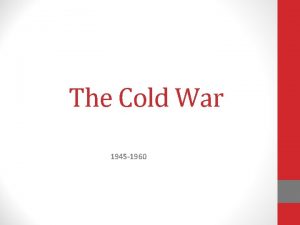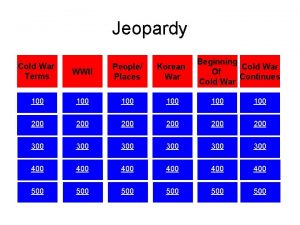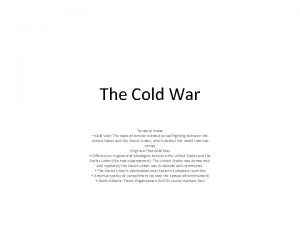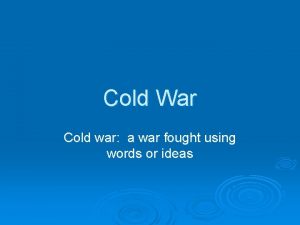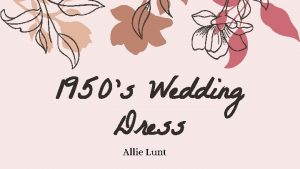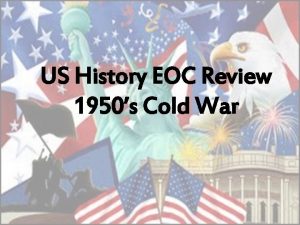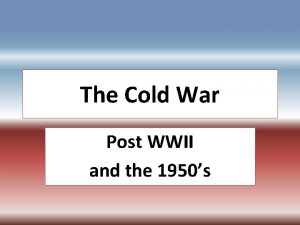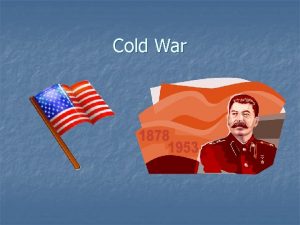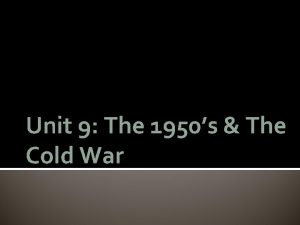Cold War Ch 24 1950s Key Terms American



























- Slides: 27

Cold War Ch. 24 (1950’s) Key Terms • American National Exhibition & Kitchen Debate • Nixon: Election of 1952 & Nixon’s Checker’s Speech • Eisenhower: Cabinet, Modern Republicanism, Interstate System, Sputnik • Massive Retaliation & Cold War Thaw • Third World • Eisenhower Doctrine • Vietnam • President Eisenhower’s Farewell Address

Cold War Presidents • • Election of 1948 Harry S. Truman (1945 – 1953) Dwight Eisenhower (1953 – 1961) John F. Kennedy (1961 – 1963) Lyndon B. Johnson (1963 – 1969) Richard Nixon (1969 – 1974) Gerald Ford (1974 – 1977) Jimmy Carter (1977 – 1981) Ronald Reagan (1981 – 1989)

Election of 1948 Truman beat Thomas Dewey despite the headlines in the Chicago Tribune and the Gallup poll. Truman finished FDR’s term when he died April 12, 1945.

Truman (1945 – 1953) • International Institutions: UN, NATO, IMF • Korean War 1950 – 1953 • Domestic Policy: -- Fair Deal (increase minimum wage, expand Social Security, Federal Aid to Education) – 2 nd Red Scare: Loyalty Program, Mc. Carthyism, HUAC, Hollywood Ten • Foreign Policy: Policy of Containment – George Kennan Long Telegram – Truman Doctrine – Marshall Plan – NSC 68

Dwight Eisenhower What were the results? • Election of 1952 • Election of 1956

Dwight Eisenhower (1953 – 1961) Military HERO • Military leader of WWII – – Supreme Commander of Operation Overlord or D Day (storm beaches of Normandy) • Supreme Commander of NATO forces • President signed armistice that ended the Korean War Ike's inaugural address – metaphor for cold war: "Freedom is pitted against slavery; lightness against dark“ VIDEO - IKE'S BIOGRAPHY (5: 43) https: //www. youtube. com/watch? v=Rx_N 1 Wcx. AQA

Eisenhower (R) 1952 Presidential Campaign President Eisenhower • Power of Television: – “I Like Ike” Eisenhower campaign slogan – 1 st time parties use TV ads to promote candidate "I Like Ike" • Eisenhower appealed to American desires for stability, pledged to go to Korea himself and end the war • Defeat Adlai Stevenson (D) both in 1952 and 1956 • 1 st President to be elected without his party controlling either house of Congress • Eisenhower &Nixon won (55% of the popular vote / 442 electoral votes to Stevenson’s 89)

Eisenhower (R) 1952 Presidential Campaign VP NIXON Nixon and the “Checker’s speech” • Ike’s spotless political record was somewhat tarnished by accusations against Nixon • Nixon accused of using a “slush fund” of campaign funds for personal use • Nixon almost dropped from Eisenhower's ticket when he was accused of spending $18, 000 from supporters in California • Nixon regained popular support by publically denying wrong doing in the “Checker’s speech” (referring to the Nixon family dog) • Focused on his good character, war service, and close-knit family • Reflects the growing importance of television on life in America

• Reflected wealth and business • Defense Secretary Charles Wilson was the former president of General Motors • A journalist described the Eisenhower administration as “eight millionaires and one plumber” Eisenhower's Cabinet

Eisenhower's Modern Republicanism Fiscal Conservatism: • Balance the budget (after years of spending under FDR and Truman) • Reduce federal spending Belief: • New Deal supported rather than rejected (Social Security, Labor laws, unemployment insurance) • Intended to lead American down the middle of the road rather than going along with views of right wing conservatives who would have dismantled New Deal • Criticized big government like other Republicans but he also didn't believe that getting rid of New Deal (FDR) and Fair Deal (Truman) programs Goals: • preserve individual freedom & market economy (mixed) • provide assistance to the unemployed and senior citizens

Eisenhower Modern Republicanism Expand New Deal programs: • Social Security extended to agricultural workers • Limited welfare state - created the Department of Health, Education and Welfare • Minimum Wage increased Interstate Highway System, 1956 (public works): (see maps and videos) http: //www. fhwa. dot. gov/interstate/homepage. cfm • Federal Aid Highway Act of 1956, 41, 000 miles of highway, goal: rapid exits from cities in event of nuclear war, support: auto industry, oil companies, suburban builders National Defense Education Act, 1957 & NASA 1958 http: //history. nasa. gov/sputnik/ • 1957 Response to Soviets launch of Sputnik, 1 st earth satellite in orbitallowed testing of ICBM (intercontinental ballistic missile) • Space Race: 1961 Yuri Gagarin (Soviet) orbit earth Video (Sputnik) http: //www. history. com/this-day-in-history/sputnik-launched Video (Space Race) http: //video. nationalgeographic. com/video/space-race-sci

Eisenhower wins again in 1956 Economic prosperity • Under Eisenhower the country enjoyed steady economic growth • Budget deficits were reduced • The postwar economy gave Americans the highest standard of living in the world and in the history of the US What happened in the election of 1956? • Ike had a heart attack in 1955, had surgery in 1956 • Democrats questioned Ike’s health as a campaign issue and nominated Adlai Stevenson again • Republicans re-nominated Eisenhower and Nixon for a 2 nd term • Four years of peace and prosperity made Ike unbeatable • Eisenhower won by a larger margin than in 1952, but Republicans lost control of Congress

A Portrait of Affluence in the United States. An employee of the Du. Pont Corp, family poses with the food they consumed in a single year, 1951. The family spent $1, 300 ($11, 000 today) on food, including 699 bottles of milk, 578 pounds of meat, and 131 dozen eggs. Nowhere in the world in 1951 was food so available and inexpensive.

Eisenhower Massive Retaliation: any attack on the US would result in nuclear war Massive Retaliation - Secretary of State John Foster Dulles • “The ability to get to the verge without getting into war is the necessary art. If you cannot master it, you will inevitably go to war… We walked to the brink and we looked it in the face. ” J. F. Dulles • Dulles believed Truman and containment had been too soft and passive • Dulles advocated the engagement of the USSR and Communist China • Brinkmanship: to bring nations to the brink of war; Dulles believed that if the US pushed the Communists to the brink of war, they would back down to American nuclear superiority • Increased reliance on nuclear weapons and airpower and less dependence on conventional forces • American nuclear warheads: 1953 - 1, 000 1960 - 18, 000 MAD (Mutual Assured Destruction) - fear led to the building of bomb shelters and school drills in response to an atomic attack Duck and Cover video: https: //archive. org/details/Duckand. C 1951 Fallout Shelters: http: //www. archives. gov/education/lessons/fallout-docs/

Eisenhower Third World • First world: industrialized western nations • Second world: the communist bloc • Third world: unindustrialized or nations in the early stages of industrialization • When European and Japanese colonial empires in Asia and Africa collapsed after WWII, the third world nations that came into existence lacked stable political and economic institutions • Third world nations in need of financial assistance became pawns in the conflict between the US and USSR

Eisenhower Third World – Iran / Guatemala Covert action in the third world • Eisenhower’s cheaper approach to fighting communism emphasized the use of covert (undercover) operations over openly using US troops • US policy often allied the US with dictators that were often ruthless and corrupt, but at least they weren’t communists • US covert actions and support of corrupt dictatorships produced anti. American feelings, especially in Latin America Iran 1953: • The CIA helped overthrow the elected government of Iran when it attempted to nationalize foreign oil companies • The overthrow allowed the shah (monarch) of Iran to return to power • The Shah purchased large amounts of US weapons and provided the west with low oil prices Guatemala 1954: • the CIA overthrew a leftist (communist) government that threatened to nationalize American businesses

Eisenhower Third World - CUBA What happened to Cuba and why was it such a big deal? • Cuban Revolution 1959: Fidel Castro overthrew Fulgencio Batista (Batista was bad, but he wasn’t a communist so the US supported him) • Castro angered the US by nationalizing American owned businesses in Cuba • Eisenhower retaliated by cutting off US trade with Cuba • Castro retaliated by turning to the USSR for support and establishing a communist state • Communism in Cuba was bad for the US because Cuba 90 miles from FL • Ike and the CIA began plans to train Cuban exiles for an invasion of Cuba (Bay of Pigs invasion) Cuba - Bay of Pigs Invasion 1961: • Towards the end of his second term, Ike had the CIA train Cuban refugees for an invasion of communist controlled Cuba • The actual attack was authorized and executed by John F. Kennedy (JFK)

Eisenhower Cold War in Korea End of the Korean War (1951 – 1953) • The war was at a stalemate along the 38 th parallel until 1953 • 1952 Presidential election won by Eisenhower in part for his campaign promise to end the war • North & South Korea agreed to an armistice July 1953: – Exchange of prisoners – The 38 th parallel as the border between the two nations

Eisenhower Cold War in Vietnam • After WWII France tried to retake its southeast Asian colony of Indochina (Cambodia, Vietnam, and Laos) • Resistance to France reclaiming Indochina (Southeast Asia) • Vietnamese and Cambodian forces fought for independence • The Vietnamese resistance was led by Ho Chi Minh (a communist) Vietnam War escalated into a Cold War conflict • Truman gave military aid to the French • The USSR and China aided Ho Chi Minh France and Eisenhower • In 1954 a large French army was trapped and forced to surrender at Dien Bien Phu • After the defeat France asked the Eisenhower to send in American troops • Ike refused The 1954 Geneva Conference • France agreed to give up Indochina • Indochina was divided into Cambodia, Laos, and Vietnam • At the Geneva Conference Vietnam was divided • Vietnam was divided at the 17 th parallel until an election could be held to unite the two halves • Ho Chi Minh established a Communist dictatorship in the north • ·Ngo Dinh Diem established an anti-communist, catholic controlled dictatorship in the south • The unify election was never held largely out of fears in the south that the communists would win

Eisenhower Cold War in Vietnam Eisenhower and South Vietnam • From 1955 to 1965 the US gave over $1 billion in economic and military aid to South Vietnam The Domino Theory: • If one nation (Vietnam) fell to communism, the other nations around it (Southeast Asia) would soon follow • Idea used by Eisenhower and later presidents to justify US support for anti-communist governments Southeast Asia Treaty Organization (SEATO) • Regional defense alliance to defend against communist expansion in southeast Asia, similar to NATO • Eight nations pledged to defend each other from communist attack: The US, Great Britain, France, New Zealand, the Philippines, Thailand, and Pakistan

Eisenhower Cold War in the Middle East Establishment of Israel • In 1948 Israel was created as a homeland for Jews • Arab nations opposed and fought the formation of Israel unsuccessfully • The US maintained a difficult balancing act of supporting the new state of Israel and at the same time keeping friendly relations with oil rich Arab states The Suez Crisis (1956) • Egypt was led by General Gamal Nasser • Nasser asked Ike and the US for funds to build the Aswan Dam on the Nile river • When the US refused, Nasser asked the USSR for funds to build the dam • The Soviets agreed to limited financial aid for the dam, but not enough to cover all costs • Seeking a new source of funds, Nasser and the Egyptians seized and nationalized the British and French owned Suez canal • Loss of the canal threatened Western trade and access to Arab oil • Britain, France, and Israel carried out a surprise attack on Egypt and retook the canal • Eisenhower, angry that he was not made aware of the invasion, sponsored a UN resolution condemning the invasion • Under pressure from US and world opinion, the invading forces withdrew • The conflict drastically reduced the influence of Britain and France in world affairs

Eisenhower Cold War in the Middle East 1957 Eisenhower Doctrine: pledge to support any Middle Eastern country resisting Communism • After the Suez conflict the US replaced Britain and France as the dominate power in the middle east • Eisenhower feared the goring influence of the USSR on the middle east • In 1957 Eisenhower announced that the US would provide economic and military aid to any middle eastern nation threatened by communism (later referred to as the Eisenhower Doctrine) Eisenhower Doctrine: 1957 http: //www. youtube. com/watch? v=Hg 5 Hn. Ax 7 c 5 c Organization of Petroleum Exporting Countries (OPEC) • In 1960 (Eisenhower’s last year in office) Saudi Arabia, Kuwait, Iraq, Iran and Venezuela formed the Organization of Petroleum Exporting Countries • The organization of nations worked together to control the amount of oil being produced and as a result the price of oil worldwide

Eisenhower Cold War Thaw Cold War "Thaw" - during Eisenhower's administration there was a period of cooperation between the US and Soviet Union; this relationship improved as a result of (1953) 1953 end of Korean War, Stalin dies 1955 Ike & Nikita Khrushchev meet in Geneva, Switzerland 1956 Khrushchev condemns Stalin's crimes publically (8 -10 million dead in purges) & possible "peaceful coexistence" 1956 (Fall) Thaw Freezes again when Hungary's anti-communists rebellion is suppressed by Soviets (Truman does not aid Hungary) 1957 Sputnik (1 st artificial earth satellite) • US response: fund higher education w/ National Defense of Education Act - Space Race http: //www. archives. gov/research/alic/reference/space-timeline. html 1958 -1961 US - Soviets halt nuclear testing National Committee for a Sane Nuclear Policy - grassroots group of pacifists that grew into a national organization pushed to end nuclear testing, citing harmful effects of radiation on public health http: //mlk-kpp 01. stanford. edu/index. php/encyclopedia/enc_national_committee_for_a_sane_nuclear_policy_sane/ 1960 US U-2 Spy Plane shot down in Soviet air space VIDEO: U-2: CIA's First Cold War Spy Plane (2: 24) https: //www. youtube. com/watch? v=xfz 6 hs-5 Rog

Eisenhower US-Soviet Relations THAW in the Cold War • Eisenhower presented a plan for slowing down the arms race called “Atoms for Peace” • The USSR withdrew troops from Austria and established peaceful relations with Greece and Turkey The Geneva Summit (1955) • Meeting between Ike and Soviet Premiere Bulganin (Stalin died on March 5, 1953 from a heart attack) • Eisenhower proposed open skies over the US and USSR • Allowing aerial photography of the opposing nation • Intended to eliminate the chance of surprise nuclear attack • The Soviets rejected the idea • Even though no agreements were made it represented the first thaw in the Cold War Nikita Khrushchev - replaced Bulganin as Premiere in 1956 • Reduced tensions temporarily by making a speech denouncing the crimes of Stalin and supporting “peaceful coexistence” between east and west The Hungarian Revolt • In October 1965 Hungarians overthrew the Soviet backed communist government • The government was briefly replaced by leaders who wanted to pull out of the Warsaw Pact • Khrushchev sent in Soviet tanks to crush the revolt and restore the communist government to power • Ike opted not to use US troops to defend Hungary for fear of starting a world war • By not defending Hungary, Eisenhower and the US indirectly recognized the Soviet Sphere of influence that existed in Eastern Europe 1958 -1961: only a temporary halt to nuclear testing

Eisenhower US-Soviet Relations THAW Sputnik - Sputnik began the space race, an extension of the arms race between the US and USSR • In 1957 the Soviets shocked the US and the world by putting the first manmade satellites Sputnik I and Sputnik II into orbit around the Earth • Challenged US military dominance by giving the USSR a delivery system for nuclear weapons (rockets that can reach space, can reach Washington DC) • The same rockets could give the USSR the ability to strike the US without warning or defense • The US relied on bombers to deliver nuclear weapons, bombers could be detected by radar • The US was further embarrassed when American rockets meant to duplicate the Soviet achievement kept blowing up How did the Soviets get ahead? • Many blamed the US educational system for not stressing science and math • 1958 National Defense and Education Act (NDEA) which provided millions of federal dollars to schools for science and foreign language education • 1958 National Aeronautics and Space Administration (NASA) to coordinate the building of US missiles and explore outer space Second Berlin crisis (1958) • After Sputnik Khrushchev looked to use his new found position against the US • Khrushchev gave the US and its western allies six months to withdraw from West Berlin - Eisenhower refused • To relieve the tension between the two nations Eisenhower invited Khrushchev to Camp David for a summit in 1959 – The two agreed to put off the conflict and meet again in 1960 in Paris 1960 U-2 Incident - American U-2 spy plane shot down in Soviet territory • Two weeks before the Paris summit, the Soviets shot down an American U-2 spy plane • After the Soviets rejected the open-skies plan, the US began using the U-2, a plane that flew higher than anti-aircraft guns could fire, to spy on the USSR • Ike accepted US responsibility for the flights after the plane was shot down • In response, Khrushchev called off the Paris summit http: //www. coldwar. org/articles/60 s/u 2_incident. asp

Cultural Exchange 1959 US & Soviet Cultural Exhibits reflect life in each country Soviet Exhibit - NYC, reflect machinery, modernization, science http: //kcmeesha. com/2012/04/08/soviet-national-exhibition-in-new-york-city/ American National Exhibit - Moscow, showcased freedom through the display of consumer goods; • soft power (influence through goods and culture) rather than hard power (military) • Freedom connected to a high standard of living rather than freedom of expression. . . • Video of Life in US (4: 23) https: //www. youtube. com/watch? v=Ob 0 a. Sy. DUK 4 A "Kitchen Debate" - Moscow, VP Richard Nixon & Soviet leader Nikita Khrushchev discuss the American exhibit; debate the merits of capitalism and communism; • 1 st debate took place in a Suburban ranch house "miracle kitchen“ Video (7: 38): http: //www. youtube. com/watch? v=-Cv. QOu. Necy 4

Eisenhower – Farewell Address What did Ike warn against in his farewell address? • He warns against the military-industrial complex • Eisenhower warned the nation to “guard against the acquisition of unwarranted influence… by the military-industrial complex” • Ike feared that the arms race and fear of communism might lead the US into giving too much power to the military or to arms manufacturers VIDEO - IKE'S FAREWELL ADDRESS - 1961: https: //www. youtube. com/watch? v=Gg-jv. Hyn. P 9 Y
 Lesson 1 the origins of the cold war
Lesson 1 the origins of the cold war Contrasting cold war terms
Contrasting cold war terms Sides of the cold war
Sides of the cold war American dream cold war
American dream cold war Chapter 26 section 2 the cold war heats up
Chapter 26 section 2 the cold war heats up Chapter 18 section 2 the cold war heats up
Chapter 18 section 2 the cold war heats up American troops fight the korean war 48a answer key
American troops fight the korean war 48a answer key The spanish american war chapter 10 section 2
The spanish american war chapter 10 section 2 Polynomial classification
Polynomial classification Finding like terms
Finding like terms Why does richards rush to tell mrs. mallard the news
Why does richards rush to tell mrs. mallard the news Computers in the 1950
Computers in the 1950 Beaniks
Beaniks Concept cars 1950s
Concept cars 1950s The affluent society 1950s
The affluent society 1950s 1950s music quiz
1950s music quiz 1950s conformity examples
1950s conformity examples Suburban life 1950s
Suburban life 1950s 1950s conformity and counterculture
1950s conformity and counterculture How were conglomerates and franchises alike and different
How were conglomerates and franchises alike and different Catcher in the rye 1950s culture
Catcher in the rye 1950s culture Daily life and popular culture in the 1950s
Daily life and popular culture in the 1950s Mass media in the 1950s
Mass media in the 1950s What groups were experiencing poverty in the 1950’s?
What groups were experiencing poverty in the 1950’s? Beat writers 1950s
Beat writers 1950s 1950s beatnik fashion
1950s beatnik fashion 1950 school punishments
1950 school punishments Color tv started
Color tv started

